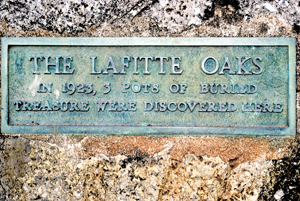A pirate’s tale
Published 12:31 pm Monday, May 16, 2011

- his plaque marks the ‘Lafitte Oaks,’ on the grounds of Jefferson Island where a worker in 1923 unearthed three boxes filled with gold and silver coins. The treasure is believed to have been buried by Jean Lafitte between the late-18th and early-19th centuries.
Like the legends of Robin Hood and King Arthur, the mystery surrounding Jean Lafitte has fascinated and prompted people throughout the Gulf Coast to lay claim to the Caribbean pirate through tales of buried treasure and secret hideouts in communities spanning from Texas to Florida, including the Teche Area.
For the 50-year reunion of the Mount Carmel class of 1960, several former students recalled old tales of Lafitte’s alleged connection to the school, which originally was the home of Frederick Henry Duperier.
Pattie Kuebler, a Mount Carmel graduate who now lives in Bowling Green, Ky., said she remembered seeing a windowpane on the second floor of the home — built about 1826 by Duperier — which then housed the Sisters of Mount Carmel.
“The window had the carved name of Jean Lafitte,” Kuebler said. “We all swore he had treasure under the kitchen.”
Another 1960 graduate of Mount Carmel, Sister Catherine Riggs of New Orleans, said she heard that Emily Duperier used an engagement ring she received from the notorious pirate to carve his name in the glass window.
“The glass pane is now preserved in the archives,” she said.
Along with the alleged window bearing Lafitte’s name, Riggs said students also speculated about the pirate’s connection to a secret tunnel beneath the school. Riggs said she remembered the tunnel being in the school’s principal’s office, and was at one time possibly used by Lafitte as an escape route to the Bayou Teche.
“I had always heard about the tunnel in Sister Rosemary’s office,” Riggs said. “In 1988 when the school was closing I finally got to see it. It was full of cobwebs. I even took a brick home with me.”
Jane Myers, also a 1960 graduate of Mount Carmel who now lives in Broussard, said she remembered another legend involving buried treasure that was left somewhere on the school’s campus by Lafitte.
“So says, the pirate Lafitte buried his treasure by the oak tree, but they’ve never been able to find it. We always talked about digging for it during our time at Mount Carmel.”
Herman Schellstede owns the former school. He said although the tunnel likely “put the fear of God” in many students of Mount Carmel, he has never been able to make a historical connection between the building and the pirate.
Although the trap-door is now sealed, Schellstede said it does appear to lead to the Bayou Teche. Since it is caved-in, however, exploring the underground tunnel is impossible.
“There’s a lot of legends and lore associated with this building, but the only story we ever found was that the tunnel was an escape route for the people who lived in the mansion centuries ago,” Schellstede said. “So they could escape to the Bayou Teche.”
To determine whether Lafitte really had a connection to the old Duperier home, The Daily Iberian contacted local artist Paul Schexnayder, who was said to have been in possession of the window bearing the carving of Lafitte’s name.
Although Schexnayder had since donated the window to the Bayou Teche Museum, he said it was not Lafitte’s name, but that of Henry Duperier, whom Emma Duperier was engaged to in the early-1800s.
Another indication Lafitte’s connection to the old Duperier home was mere legend can be attributed to the year the pirate is believed to have died, which according to historian Charles Gayarre, was in 1826. That also was the year the Duperier home was supposed to have been built, according to Glenn Conrad’s “New Iberia: Essays on the Town and its People.”
Yet, Conrad wrote of several potential connections the pirate did have to the Teche Area, notably in New Iberia and at Jefferson Island. Referencing the digging of the Attakapas Canal and its use for commercial activity by the area’s first European colonists, Conrad mentioned two people with possible links to Lafitte: Isaac Randolph and Francois Mongault.
Conrad described Randolph and Mongault as “agents of Lafitte in their smuggling operations; as well as in the slave traffic.”
According to Conrad, Mongault was the original owner of the property that was eventually used to build St. Peter’s College, which is now the site of the Iberia Parish Library on Main Street.
“The original owner was said to be associated with Lafitte in his smuggling operations around Vermilion Bay … (e)ngaged in the heinous slave traffic, their memories are associated with all that is barbarous in the annals of civilization,” Conrad wrote. “Whether or not Mongault was associated with Lafitte remains a matter of speculation.”
Mongault sold his property along the Bayou Teche to Elizabeth Norwood in 1813, according to Conrad.
Randolph, another potential connection to Lafitte mentioned by Conrad, was one of the first owners of Jefferson Island, when it was known as “Orange Island.”
Local historian Shane Bernard said it is believed that Randolph was Lafitte’s brother-in-law.
“That’s the only story I’ve heard linking him to this area,” Bernard said. “But I’m pretty skeptical of all the Lafitte claims. It may or may not be true if he was really related to Lafitte or not. It’s sort of like the ‘George Washington slept here’ claim.”
According to Lafitte historian Jack Ramsey, who wrote the pirate’s biography, Randolph was a Scotchman who purchased Orange Island in 1820. Yet, after a failed attempt to convert the land, previously used for cattle grazing, into sugar cane fields, it was seized in June 1833 and sold to John Brownson.
After changing ownership several times, the land was eventually sold by the heirs of actor Joseph Jefferson to John Bayless Sr., in 1917. Six years later, treasure was discovered on the property.
The discovery happened in 1923 when a work-crew foreman named “Daynite” unearthed three pots of doubloons while digging a culvert at Jefferson Island, said Ed Portier, a Jefferson Island tour guide.
Buried in three metal boxes, Daynite’s discovery included French, English and Spanish coins, made of both gold and silver, and all being minted in the 1700s, Portier said.
Although Daynite attempted to steal the treasure, Portier said Bayless successfully tracked him down, and was able to recover some of the discovery, which is now on display inside the Joseph Jefferson home.
The treasure was found buried underneath two Live Oaks, which have since been named the “Lafitte Oaks,” Portier said, adding he believes the name is fitting since the treasure likely was stored on the island by the infamous pirate.
“It’s a very short skip from Vermilion Bay to the island, where there’s a lot of tall oaks to hide out. When the tide was right it’s easy to get in, and easy to get back out at night, as long as you wait for the nighttime land breeze,” Portier said. “My guess is that it is his treasure because they also found a pirate’s knife on the property.”
The knife is the same shape as knives traditionally used by Caribbean pirates in the 17th and 18th centuries, Portier said, adding, it’s short, and built without a hilt, making it easier for stabbing because it took away the chance for the weapon to become stuck in the victim’s ribcage.
“Pirate’s knives never had a hilt,” he said. “And when Lafitte buried a treasure, he always brought one guy with him. They would go out together and once they finished burying the treasure he would kill the other pirate so a ghost would be there to guard his treasure.”





